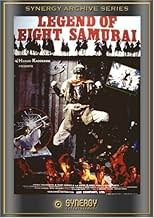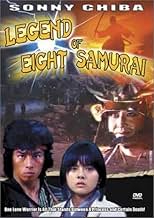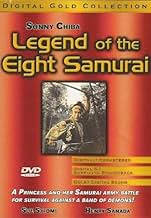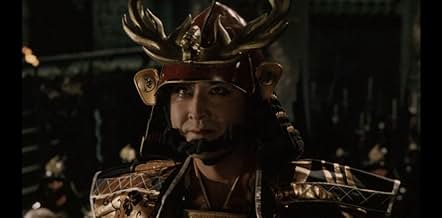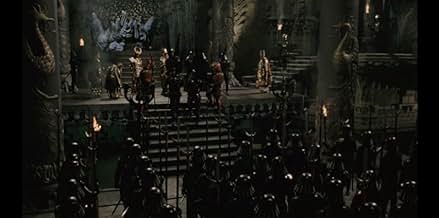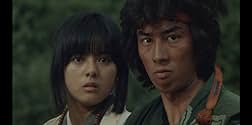AVALIAÇÃO DA IMDb
6,4/10
1,5 mil
SUA AVALIAÇÃO
A Princesa Shizu é sequestrada por um grupo do maléfico Império das Trevas, que está espalhando o mal por várias regiões. Então, um grupo de samurais recebe a missão de resgatá-la, envolvend... Ler tudoA Princesa Shizu é sequestrada por um grupo do maléfico Império das Trevas, que está espalhando o mal por várias regiões. Então, um grupo de samurais recebe a missão de resgatá-la, envolvendo-se em combates épicos contra o Império.A Princesa Shizu é sequestrada por um grupo do maléfico Império das Trevas, que está espalhando o mal por várias regiões. Então, um grupo de samurais recebe a missão de resgatá-la, envolvendo-se em combates épicos contra o Império.
- Direção
- Roteiristas
- Artistas
- Prêmios
- 4 indicações no total
Shin'ichi Chiba
- Inuyama Dosetsu Tadatomo
- (as Sonny Chiba)
Kenji Ôba
- Inukai Genpachi Nobufuchi
- (as Kenji Ohba)
Keiko Matsuzaka
- Princess Fuse
- (narração)
- Direção
- Roteiristas
- Elenco e equipe completos
- Produção, bilheteria e muito mais no IMDbPro
Avaliações em destaque
LEGEND OF THE EIGHT SAMURAI (1983) is a live-action Japanese costume fantasy retelling the oft-told tale of eight warriors identified by their receipt of magic crystal balls sent by a long-dead princess to insure protection of her descendants. Here, the eight warriors who receive the crystal balls come together to protect the fugitive Princess Shizu of the Satomi Clan, which has been all but wiped out by the supernatural descendants of the Hikita Clan. The action is larded with fantasy elements, including a couple of monsters (a giant centipede and giant snake) and the long-lived evil matriarch Tamazusa (Mari Natsuki) who stays alive a hundred years after her 'death' at the hands of the Satomi Clan by taking special baths in blood.
Despite the title, there's no mention of samurai in the film's English-dubbed dialogue. The characters refer to each other as ninjas, even though few ninja costumes or accessories are visible. It's an unwieldy film with over a dozen major characters, none of whom take center stage until well past the film's half-way mark. The main focus of the plot is the gathering of the eight warriors as they meet and realize their destiny to protect the princess and attack Tamazusa's castle to destroy the Eternal Spirit who keeps alive the evil remnants of the Hikita Clan. Too much of the film is spent on gathering the eight, a task which is not completed until 100 minutes into the 133-minute film. When things finally get going here, the main characters turn out to be Princess Shizu (Hiroko Yakushimaru) and the reckless young Shinbei (Hiroyuki Sanada) who kidnaps Shizu at one point and travels quite a distance with her before they're reunited with the others. Both are too callow and unformed to be of much interest, while the more exciting characters, such as the loyal retainer Dosetsu (Sonny Chiba) and the female fighter Kano (Sue Shiomi), get far less screen time.
The climactic battle at Castle Tamazusa is rousing and full of action, but it proves too little too late to compensate for the two hours it took to get there. The earlier action scenes are all too short and choppy to generate much excitement. To make matters worse, the English dubbing is particularly horrendous and the tacked-on music score is all synthesizer-created with three incongruous American pop songs (sung by John O'Banion) thrown onto the soundtrack with utter disregard for the historical and cultural tone of the film.
The film is especially disappointing because it was directed by Kinji Fukasaku, a highly regarded director known for Yakuza (gangster) films and the recent box office hit BATTLE ROYALE (2000). His earlier space opera, MESSAGE FROM SPACE (1978), was a variation of the same story told in LEGEND OF THE EIGHT SAMURAI and featured some of the same cast members, Hiroyuki Sanada, Sonny Chiba and Sue Shiomi (who played the princess in that one). Fukasaku also gave us the U.S.-Japanese co-production, THE GREEN SLIME (1968).
On the plus side, LEGEND OF THE EIGHT SAMURAI is quite colorful and beautifully appointed and the special effects are, for the most part, pretty impressive. (The giant centipede, flung about on wires, is the notable exception.) But the film lacks the formal beauty of traditional Japanese samurai films and seems pumped up in style, with the youthful romance played up, in order to suit the 1980s youth audience. For U.S. fans, the botched English soundtrack and over-length are quite fatal, along with the absence of any exceptional action scenes until the very end. The story comes from the 19th century Japanese novel 'Nanso Satomi Hakkenden,' by Bakin Takizawa, which was also the basis for the breathtaking 13-part animated series, THE HAKKENDEN (1990). Elements of the story also turn up in the original 'Dragon Ball' animated TV series.
Despite the title, there's no mention of samurai in the film's English-dubbed dialogue. The characters refer to each other as ninjas, even though few ninja costumes or accessories are visible. It's an unwieldy film with over a dozen major characters, none of whom take center stage until well past the film's half-way mark. The main focus of the plot is the gathering of the eight warriors as they meet and realize their destiny to protect the princess and attack Tamazusa's castle to destroy the Eternal Spirit who keeps alive the evil remnants of the Hikita Clan. Too much of the film is spent on gathering the eight, a task which is not completed until 100 minutes into the 133-minute film. When things finally get going here, the main characters turn out to be Princess Shizu (Hiroko Yakushimaru) and the reckless young Shinbei (Hiroyuki Sanada) who kidnaps Shizu at one point and travels quite a distance with her before they're reunited with the others. Both are too callow and unformed to be of much interest, while the more exciting characters, such as the loyal retainer Dosetsu (Sonny Chiba) and the female fighter Kano (Sue Shiomi), get far less screen time.
The climactic battle at Castle Tamazusa is rousing and full of action, but it proves too little too late to compensate for the two hours it took to get there. The earlier action scenes are all too short and choppy to generate much excitement. To make matters worse, the English dubbing is particularly horrendous and the tacked-on music score is all synthesizer-created with three incongruous American pop songs (sung by John O'Banion) thrown onto the soundtrack with utter disregard for the historical and cultural tone of the film.
The film is especially disappointing because it was directed by Kinji Fukasaku, a highly regarded director known for Yakuza (gangster) films and the recent box office hit BATTLE ROYALE (2000). His earlier space opera, MESSAGE FROM SPACE (1978), was a variation of the same story told in LEGEND OF THE EIGHT SAMURAI and featured some of the same cast members, Hiroyuki Sanada, Sonny Chiba and Sue Shiomi (who played the princess in that one). Fukasaku also gave us the U.S.-Japanese co-production, THE GREEN SLIME (1968).
On the plus side, LEGEND OF THE EIGHT SAMURAI is quite colorful and beautifully appointed and the special effects are, for the most part, pretty impressive. (The giant centipede, flung about on wires, is the notable exception.) But the film lacks the formal beauty of traditional Japanese samurai films and seems pumped up in style, with the youthful romance played up, in order to suit the 1980s youth audience. For U.S. fans, the botched English soundtrack and over-length are quite fatal, along with the absence of any exceptional action scenes until the very end. The story comes from the 19th century Japanese novel 'Nanso Satomi Hakkenden,' by Bakin Takizawa, which was also the basis for the breathtaking 13-part animated series, THE HAKKENDEN (1990). Elements of the story also turn up in the original 'Dragon Ball' animated TV series.
SATOMI HAKKENDEN (Literally `Satomi (Clan) Eight Dog (Samurai) Legend') is a silly yet enjoyable romp that is a true guilty pleasure for Japanese Action Movie fans, mixing elements of Fantasy, Romance, Adventure and Traditional Samurai Drama (Chambara).
Inspired by the massive 106 Volume, 1814 epic Japanese novel `Nanso Satomi Hakkenden,' by Takizawa (Kyokutei) Bakin, SATOMI HAKKENDEN attempts to modernize and reinterpret the legend of the Eight `Dog' Heroes of the Satomi Clan of Awa Province, whose Princess Fume upon her tragic death gives birth to the Hakkenshi (Eight Samurai) whose spirits are reincarnated in human form carrying mystic crystal beads signifying the virtues of Confucianism (Jin-Sympathy, Gi=Duty/Justice, Rei=Proper Form, Chi=Wisdom, Chuu=Loyalty, Shin=Faith, Kou=Filial Piety, and Tei=Brotherly Affection).
Shizu (Yakushimaru, Hiroko) is a descendent of Princess Fume and is being hunted by the sinister forces of the Hikita Clan, whose Black Magic wielding, Lady Tamazusa (Natsuki, Mari) needs Shizu's blood to give herself eternal beauty (somewhat Snow White-like). Enter the Hakkenshi who attempt to protect Shizu from Tamazusa's minions and her Black Magic spawned threats. During the course of their adventures, Shizu falls in love with one of her protectors, the wild-child Shinbei (Sanada, Hiroyuki) who just so happens to be the bastard son of Lady Tamazusa.
1980's `Super Producer', Hiroyuki Kadokawa and legendary maverick director Kinji Fukusaku team-up once again to bring together this loud, Special-Effects laden spectacular with mixed results.
The action is superb, compliments to Chiba, Shinichi (aka J.J./Sonny Chiba), Shiomi, Etsuko (aka Sue Shiomi) and the rest of the Japan Action Club and their unique blend of swordplay and martial arts action.
Much time is spent on the romance between Shizu and Shinbei. At the time Yakushimaru was the darling of Japanese Cinema, having just come off of her Box Office smash hit `Sailor Fuku Tou Kikanju' (Sailor Dress and Machinegun) and Kadokawa wastes little time exploiting her new found popularity.
Yet, the story is slow at times and often confusing as a parade of characters march past the screen. Characterization for the Hakkenshi is almost non-existent, save for their stereotypical attributes (the staunch leader, the brooding androgynous samurai, the mysterious warrior princess, the tall and silent muscleman, the token kid and the `bad-guy' turned `good guy').
SATOMI HAKKENDEN is a pure `popcorn' movie for the teenage set.
Inspired by the massive 106 Volume, 1814 epic Japanese novel `Nanso Satomi Hakkenden,' by Takizawa (Kyokutei) Bakin, SATOMI HAKKENDEN attempts to modernize and reinterpret the legend of the Eight `Dog' Heroes of the Satomi Clan of Awa Province, whose Princess Fume upon her tragic death gives birth to the Hakkenshi (Eight Samurai) whose spirits are reincarnated in human form carrying mystic crystal beads signifying the virtues of Confucianism (Jin-Sympathy, Gi=Duty/Justice, Rei=Proper Form, Chi=Wisdom, Chuu=Loyalty, Shin=Faith, Kou=Filial Piety, and Tei=Brotherly Affection).
Shizu (Yakushimaru, Hiroko) is a descendent of Princess Fume and is being hunted by the sinister forces of the Hikita Clan, whose Black Magic wielding, Lady Tamazusa (Natsuki, Mari) needs Shizu's blood to give herself eternal beauty (somewhat Snow White-like). Enter the Hakkenshi who attempt to protect Shizu from Tamazusa's minions and her Black Magic spawned threats. During the course of their adventures, Shizu falls in love with one of her protectors, the wild-child Shinbei (Sanada, Hiroyuki) who just so happens to be the bastard son of Lady Tamazusa.
1980's `Super Producer', Hiroyuki Kadokawa and legendary maverick director Kinji Fukusaku team-up once again to bring together this loud, Special-Effects laden spectacular with mixed results.
The action is superb, compliments to Chiba, Shinichi (aka J.J./Sonny Chiba), Shiomi, Etsuko (aka Sue Shiomi) and the rest of the Japan Action Club and their unique blend of swordplay and martial arts action.
Much time is spent on the romance between Shizu and Shinbei. At the time Yakushimaru was the darling of Japanese Cinema, having just come off of her Box Office smash hit `Sailor Fuku Tou Kikanju' (Sailor Dress and Machinegun) and Kadokawa wastes little time exploiting her new found popularity.
Yet, the story is slow at times and often confusing as a parade of characters march past the screen. Characterization for the Hakkenshi is almost non-existent, save for their stereotypical attributes (the staunch leader, the brooding androgynous samurai, the mysterious warrior princess, the tall and silent muscleman, the token kid and the `bad-guy' turned `good guy').
SATOMI HAKKENDEN is a pure `popcorn' movie for the teenage set.
Swords and sorcery films are one of my preferred genres and a pleasant pass time for me and when I came across this lesser known gem of a movie; imagine my surprise when (for me at least) it ticked most if not all boxes. In fact this is not a S&S movie like say "The sword and the sorcerer" or the two original "Conan" movies but it is an enjoyable (cheesey) rendition of the genre. It wold be better to say that this is a genre of it's own, namely Samurai, magic and princesses. OK, so what did I make of this hokey and laughable highly enjoyable film? Well...in a nutshell...I really enjoyed it. Slow to start off but stick with it and it grows on you. Of course we have the well known actor Sony Chiba in this (from "kill Bill" as if you don't know) which is reason alone to see this. There was one song in this that got stuck in my head and I had to know what it was called. Having hit a dead end using Siri on my iPhone to identify the song I headed to the good ol' internet and IMDb where i discovered that the song was written especially for the dubbed version of this movie and not a bonafied standalone song. Nevertheless I managed to get a copy and play it on iTunes now.I would love to know what other people make of this movie and the soundtrack so if you are into sword, sorcery, samurais and light shows (don't ask) then give this a chance. Hopefully, you'll enjoy it as much as I did.
Although based on a classic Japanese novel, Legend of Eight Samurai owes an awful lot to the work of George Lucas, with plenty of moments inspired by (ie., borrowed from) Hollywood blockbusters Star Wars and The Empire Strikes Back, with even the occasional nod to Raiders of the Lost Ark; but hey, that's OK, because George owes a lot of his success to Japanese cinema. What goes around comes around, as they say.
An epic fantasy tale of good versus evil, complete with gorgeous princess, handsome heroes, and a wicked villain in a heavily guarded fortress, this is unashamed popcorn action aimed at an international market. A great cast (including Japanese action legend Sonny Chiba, international star Hiroyuki Sanada, and the extremely cute Hiroko Yakushimaru), spectacular stunts from Chiba's Japan Action Club, flashy special effects, and brisk direction from Kinji Fukusaku ensure that the film is consistently fun throughout, despite the somewhat random nature of the plot and a running time that clocks in at well over two hours. Fukusaku also manages to lend the whole thing a touch of class with his stylish visuals, giving those of an artistic bent something to appreciate amidst the film's many crowd-pleasing battles.
NB. For what sounds like ideal family fare, there is a touch of surprisingly gruesome imagery and some brief nudity which may deter those looking for something non-offensive to entertain the kiddies. For me, though, a witch tearing her face off, the occasional decapitation, and the sight of a naked woman bathing in blood only added to my overall enjoyment.
An epic fantasy tale of good versus evil, complete with gorgeous princess, handsome heroes, and a wicked villain in a heavily guarded fortress, this is unashamed popcorn action aimed at an international market. A great cast (including Japanese action legend Sonny Chiba, international star Hiroyuki Sanada, and the extremely cute Hiroko Yakushimaru), spectacular stunts from Chiba's Japan Action Club, flashy special effects, and brisk direction from Kinji Fukusaku ensure that the film is consistently fun throughout, despite the somewhat random nature of the plot and a running time that clocks in at well over two hours. Fukusaku also manages to lend the whole thing a touch of class with his stylish visuals, giving those of an artistic bent something to appreciate amidst the film's many crowd-pleasing battles.
NB. For what sounds like ideal family fare, there is a touch of surprisingly gruesome imagery and some brief nudity which may deter those looking for something non-offensive to entertain the kiddies. For me, though, a witch tearing her face off, the occasional decapitation, and the sight of a naked woman bathing in blood only added to my overall enjoyment.
Satomi Hakkenden will be understood the moment the viewer realizes that the soulful, classically Japanese score is being played on a cheap Casio synthesizer, and that somehow that is good. Being one of the country's very traditional legends (stolen from China), the writers drew from literary sources to make their movie, and it shows. The movie has heaping doses of melodrama, decapitations, and dead children. It also has characters dressed like a costume shop exploded, giant flying snakes hanging by ropes, a truly terrible 70's power ballad love song, and a plot so stereotypically Japanese it can be considered prototypical.
None of that is to say that the movie is bad. All of those things add to the ambiance of the movie. It also contains incredible special effects for 1983, some of the moments are surprisingly poignant, and the fight scenes are great. The plot may be telegraphed from a mile away, but it is still entertaining to watch it all unfold. If you are at all a fan of Japanese culture, you have seen this movie before, in one way or another. Yet if this sounds at all appealing to you, you owe it to yourself to see the original. Satomi Hakkenden deserves a larger spot in great camp history.
None of that is to say that the movie is bad. All of those things add to the ambiance of the movie. It also contains incredible special effects for 1983, some of the moments are surprisingly poignant, and the fight scenes are great. The plot may be telegraphed from a mile away, but it is still entertaining to watch it all unfold. If you are at all a fan of Japanese culture, you have seen this movie before, in one way or another. Yet if this sounds at all appealing to you, you owe it to yourself to see the original. Satomi Hakkenden deserves a larger spot in great camp history.
Você sabia?
- CuriosidadesIn the public domain on VHS and DVD.
- Erros de gravaçãoWhen Shinbei goes "evil" and attacks the princess and her friends when he jumps off the back of the horse you can see the black wire that's attach to his back that's keeping him off the ground. Futhurmore if you check out the top corner of the screen you can see the winch that the other end of the wire is connected to swinging around.
- ConexõesFeatured in The Playlist: Instruments of Destruction (2012)
Principais escolhas
Faça login para avaliar e ver a lista de recomendações personalizadas
- How long is Legend of the Eight Samurai?Fornecido pela Alexa
Detalhes
- Data de lançamento
- País de origem
- Idioma
- Também conhecido como
- Legend of the Eight Samurai
- Empresas de produção
- Consulte mais créditos da empresa na IMDbPro
- Tempo de duração
- 2 h 13 min(133 min)
- Cor
- Mixagem de som
- Proporção
- 1.85 : 1
Contribua para esta página
Sugerir uma alteração ou adicionar conteúdo ausente

